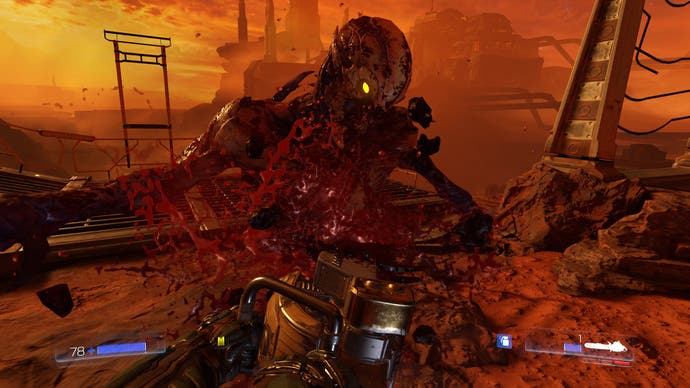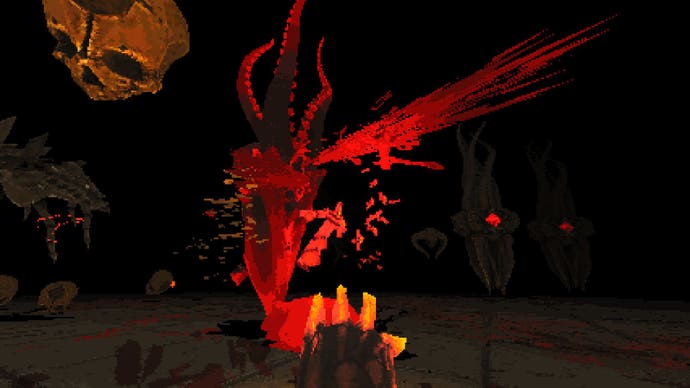The year single-player shooters reclaimed their former glory
How Doom, Titanfall 2 and Devil Daggers transformed a dying art.
Every so often a games comes along that is so revolutionary that it inadvertently kills its genre as everyone scrambles to replicate its success. For shooters, that game was Epic's 2006 shooter Gears of War. As covered in Tom Bissell's excellent book Extra Lives: Why Video Games Matter, Gears of War creator Cliff Bleszinski re-imagined the shooter genre as one of chaos and fear. Where big meaty soldiers would still feel vulnerable when faced with the onslaught of enemy fire chipping away at concrete mere inches from their face. In short, Gears of War wanted to change the old nature of "war is horrible, but isn't this fun?!" with "war is terrifying for even the most macho of soldiers, but doesn't it make you feel alive?" It's a subtle distinction, but an important one. Shooters were no longer about catharsis - or rather they weren't just about catharsis: they had to instil a feeling of vulnerability.
That's fine for some games (it worked for Gears), but it shifted the pulse of the genre's single-player side from the free-wheeling escapist fantasies of the original Doom into the the Michael Bay style of excess by default. How many 'splosions can we have? Can we cram more NPCs into this battle? Is this shootout "cinematic" enough?
Ironically, this focus on excess took away from the freeform interactive thrills that made the genre popular. Soon, the lion's share of shooters would look exciting, but in terms of interactivity they'd became increasingly content to let players cower behind cover while scripted series of enemies would filter in following the same familiar patterns. No matter how rousing the surface details were, the bulk of shooters in the last decade came down to cautiously popping in and out of cover.
This year, however, we had a few absolutely terrific single-player shooters that bucked this trend in a variety of different ways.

Titanfall 2 managed this through a couple of different methods. The first is wall-running, a move so effortlessly entertaining that it really ought to have joined the double-jump as the industry norm for traversal. Zipping about slick perpendicular surfaces really opens up your navigation options as it totally rewrites the rules of a 3D space. Suddenly those balconies and ledges can be accessed in no time as typically mundane surfaces like walls (a concept so banal that when Pink Floyd uses it as a symbol for conformity everyone knows exactly what they're talking about) are transformed into opportunities for speed boosting acts of derring-do.
The other way Titanfall 2 prevents fighting fairly staid hordes of NPC grunts from feeling stale is though sheer variety. As Chris Donlan noted earlier this year, Titanfall 2 isn't just a shooter: it's also a platformer and a puzzle game. Its best level, Effect and Cause, is less about lining up headshots as it is bending time to warp between two equally hazardous realities. Another memorable setpiece involves a factory where those walls Titanfall 2's convinced me to like so much keep reorienting themselves in a drifting assembly line of soulless suburban dwellings. Finally, all those moving parts that have signified a Call of Duty setpiece for the last decade aren't shifting around just to look cool, but to actually provide a new style of play. Neat!
I do have one gripe about Titanfall 2's single-player, however. As stirring as its traversal and variety are, when played on the hardest difficulty there are still quite a few on-foot sequences where the most practical way to play isn't the most fun. Scurrying about the scenery is a hoot, but too often the coward's approach of politely thinning out the heard while toggling in and out of cover at a safe distance can be too effective. But that's the exception in Titanfall 2, not the rule as it is in many contemporary shooters.
A 2016 FPS that more effectively obliterates this instinct to duck and hide is id Software's astounding reboot of Doom. In Doom, you have to keep moving. Only once or twice in the entire dozen-plus hour single-player campaign are there hidey holes that you can exploit. Enemies come at you relentlessly from all angles and if you stop, even for a second, you're going to be very, very dead (at least on the harder difficulty settings).

Like most shooters, Doom's combat encounters technically follow a set pattern, but they're so complex that there's no way to accurately follow them beyond the vague knowledge of what batches of monsters are coming up. Since enemies teleport into existence and you're encouraged to always be sprinting about, it quickly becomes impossible to memorise the enemies' marks. After a decade of shooters encouraging players to sneak about and take cover, Doom reminded me that what made the genre so thrilling in the first place wasn't the headshots, but the adrenaline rush of scampering about a spooky terrain.
Where Titanfall 2 added many non-shooter mechanics to its campaign, Doom proudly excised any superfluous cargo. Not only is there barely a story (one that takes up between maybe five minutes of its umpteen-hour campaign, which is still five minutes too much), but there's plenty of shooter conventions wilfully discarded. Reloading, as a concept, is completely omitted. Sure it doesn't make any sense that your shotgun can hold over 40 shells in its modest chamber, but this is explained through the unspoken but commonly understood logic of "this is a video game".
It's also worth noting that Doom never takes itself seriously. There's no dramatic arc where a comrade dies or someone explains the importance of your mission. In fact, when someone tried to do the latter in the game's opening minutes, the comically mute Doom Marine simply tosses away the monitor in complete indifference to the plot of the game he's starring in. As Donlan pointed out the guy you're playing as in Doom is playing Doom.
And if Doom wasn't great enough as it was, the developer later released a brilliant score attack Arcade Mode, which effectively took the game's cocaine-addled pacing and laced it with Angel Dust. Suddenly downtime was meant to be sped through to keep your kill-based score multiplier in peak form rather than a methodical exploration of the level designer's penchant for hiding secrets - scavenging for which is an entertaining puzzle-based diversion the first time, but a chore upon replaying.

While Doom offers a stripped down approach to the increasingly convoluted genre, Steam hit Devil Daggers offered an even more minimalist take on the act of running and shooting. Offering only one weapon, no backstory, and only a single basic square map in a pitch black abyss, Devil Daggers tasked folks with surviving an endless onslaught of demonic creatures. It starts simple, but if you can survive longer than a minute (already an impressive feat given that you die in one hit), you'll quickly become lost in its convoluted chaos of demonic glory. Devil Daggers is obviously not as robust as Doom or Titanfall 2's full-priced retail campaigns, but the £3.99 indie affair still went a long way toward reinvigorating the lifebood of the genre.
Doom, Titanfall 2 and Devil Daggers feel essential in an age where the shooter has been adopted as the populist toolkit of the generic, gritty grimdark macho mentality. All three titles remember that shooters weren't always about overcoming the odds while getting pinned down, but rather escapist fever-dreams about being a super soldier slaying Robo-Hitler. But it's not just the thematic light-heartedness that puts these games so far afield from their peers: it's their woefully different designs that offer a more aggressive take on the virtual firefight. 2016 was the year that reminded me that the big, dumb shooter could still be relevant in the enlightened age of Firewatch, The Witness, and That Dragon, Cancer. 2017 is going to have a hard time following up such a strong showing, but I have faith that the genuinely brilliant single-player shooter renaissance is just getting started. I mean, have you seen Strafe?









